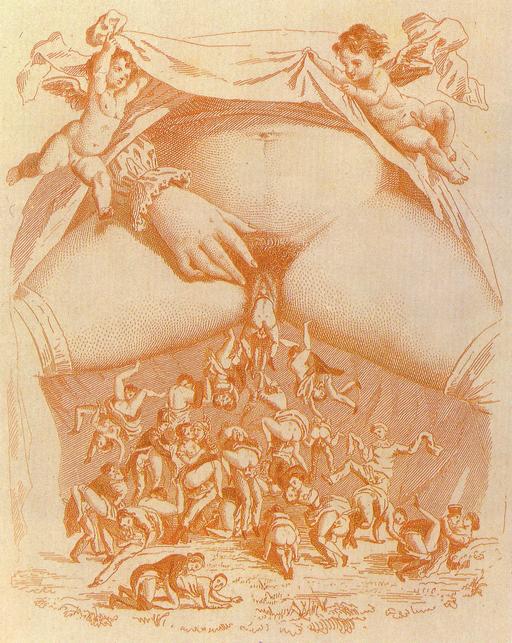February 18th, 2013 -- by Bacchus
The Center Of The World
I can’t claim to understand what Jules Adolphe Chauvet thought he was playing at when he created this image in 1848 and named it “The Center Of The World”. I can guess, but there’s so much difference between his world and mine, it’s likely I’d get it ridonkulously wrong. So I’ll just post it and let y’all wrassle for yerselves with the image of all the little copulating people being squirted out of the Vagina Of The Fifty-Foot Woman:

Found at Feeling Is First.
Similar Sex Blogging:
This entry was posted on Monday, February 18th, 2013 at 9:38 am. You can follow any responses to this entry through the RSS 2.0 feed. You can leave a response, or trackback from your own site.
Shorter URL for sharing: https://www.erosblog.com/?p=9366
Shorter URL for sharing: https://www.erosblog.com/?p=9366








A sort of visual source-text for (or one that stems from a common trope as) Gustave Courbet’s L’Origine du monde (1866), perhaps?
[Here’s a link for the lazy: L’Origine du monde — Bacchus]
That’s the first time I’ve noticed cherubim (holding up her petticoat left and right) endowed with genitalia.
I suppose one interpretation would be that the argument could be made, that the purpose of life, is to reproduce.
Not only do the lives of the male preying mantis and black widow spider usually end immediately after the reproductive act, but in the insect world, it is the caterpillar that does all the eating. Once it molts into a moth or butterfly, it lacks the mouth parts for chewing, and its life only lasts for about a day. …just long enough for it to fly to a mate, and achieve the act of reproduction, then lay the fertilized eggs in a mass on an appropriate food source.
There are a few exceptions, such as the monarch butterfly, which have a proboscis allowing it to suck nutrient-rich nectar which it needs for a longer search (to a migratory orgy), and to later travel from (larval food source) plant to plant, laying as few as one egg on each individual plant.
Once they reach adult reproductive age, they stop growing…
Many animals get sick and die, quite shortly after reproduction (unless they are mammals, which require suckling until they are old enough to take care of themselves).
If you are of a religious bent, such Bible passages as God’s directive to “go forth and multiply” would apply here also. (Genesis 1:28, Genesis 9:1, et cetera…)
In the plant world, all annual plants die shortly after bearing fruit (which contain the reproductive seeds…).
If you remove the flowers/fruits/seeds of a plant, it will live longer in most cases, and struggle to once again reach a stage of reproductive capability.
I think what the artist is saying is, that we are all here to fuck. We all came from a vagina, as a result of fucking…
From one comes many.
Casanova called Venice the Center of the World. Although this is hardly a tourist poster.
Bibliomane has a Picasa album of Jules Adolphe Chauvet’s illustrations for limited-edition works, including “Tales of a new kind laughter and more fun by the Collier Citizen.” [Thank you Google Translate.]
The “naked blind man’s buff” picture in that album is my new favorite example of ” Ã rire d’un nouveau genre et des plus amusants.”
A really interesting satirical representation!
The question seems to be: The copulating people, do they fall out of the „Center” or are they attracted by and finally drawn into it?
I think, the artist, in his satirical manner, used a scheme of ascension developed by Michelangelo for the dead rising from their graves and ascending to heaven on the left side of his Last Judgement in the Sistine Chapel.
Starting from couples on the ground there are others standing up, others lifted by their passion from the ground rising upwards, sometimes forming chains by helping each other, all heavily attracted by the „Center” and finally drawn into it. The whole society is involved: There are priests, ancient and modern soldiers, citoyens, even Harlequin is involved.
And by the way: The little ones lifting the skirt are „amorini”, little Amors, not cherubim.